Do not know what to do with the child to bring both benefit and pleasure? Try together a little bit to create.
Contents
- How does creativity affect the development of children?
- Types of creativity for the development of the child
- The role of drawing in the development of the baby. Drawing tools
- Drawing paints( finger, watercolor, gouache).
- Drawing with gouache
- Drawing with pencils( classical, watercolor, wax)
- Drawing with felt-tip pens( classic, water-soluble, for boards, with stamps)
- Drawing with crayons
- Working with plasticine or modeling test and its impact on the development of the child
- The use of modeling
- The use of molding for health
- The use of molding for the development of personality
- Materials for stamping
- Plasticinography
- The use of applique in child development
- The use of applique in the development of the mouse
- Materials for application
- Sequence of actions for employment by application from paper
- Application of cereals
- Other types of creativity
- VIDEO: Classes with creativity with the child 2-3 years. An interesting educational film for parents
Creativity undoubtedly affects the child, his development, skills, character. It teaches the baby self-expression, helps to know the world, to see it with your own eyes. The child who is engaged in creativity, can go beyond the boundaries of the generally accepted, and thanks to this overcomes the problems that arise, because he has many options for solving them. In addition, working together, children and parents come together, interact better and understand each other.
 Drawing gouache
Drawing gouache How does creativity affect the development of children?
For six months, babies can begin to create. Of course, not without the help of adults. Creativity at this age develops the imagination of the child, helps him become more assiduous, improves the fine motor skills of the hands.
The kid needs to be given complete freedom in creativity, let him draw as he wants, what he wants and where he wants, if this, of course, is not a new wallpaper. Full freedom of action develops the imagination of the child, he feels more confident, independent.
Creativity helps children develop:
- Give your baby colors, pencils or markers. Drawing will help to train fingers and pens, and this is a very good exercise for coordinating the hands and eyes. In the future, such creativity will help the child to better cope with chopsticks and hooks in spelling lessons.
- Joint drawing or other games, for example, building a tower, help children socialize and learn how to work in the
- team. During drawing, the child gets acquainted with flowers, shape. They pay attention to small details in order to then correctly draw them, thus developing the observation
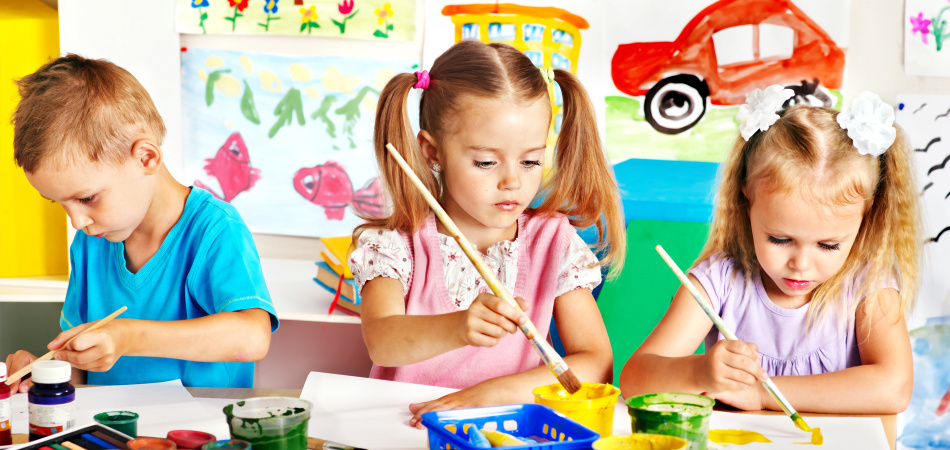
- Drawing class
- . When engaged in creativity, children see and present unusual things, changing the colors, size, shape of something familiar. Thanks to this, they can look at the world from the other side of the
- . If children are praised for their success in creativity, they grow in self-confidence and self-esteem
- . With the imagination, it makes the child experiment, invent something new, thanks tothis children receive new skills
Types of creativity for the development of the child
The child is more sensitive to the adult, because for him this is the first time, he perceives everything differently, brighter, more emotionally. He sees colors differently, hears sounds, feels the texture. Therefore, the child needs to know the world through tactile sensations, find a way out for his emotions.
There are the following types of creativity for children:
- Drawing
- Modeling
- Plasticinography
- Application
- Others
Below we will look at all these types of details and find out how they affect the development of children.
The role of drawing in the development of the baby. Drawing tools
Drawing is probably the most famous and widely used type of creative activity. Through drawing, the child develops memory, learns to focus, improves fine motor skills, analyzes everything, compares, looks for differences, drawing makes the child think and think.
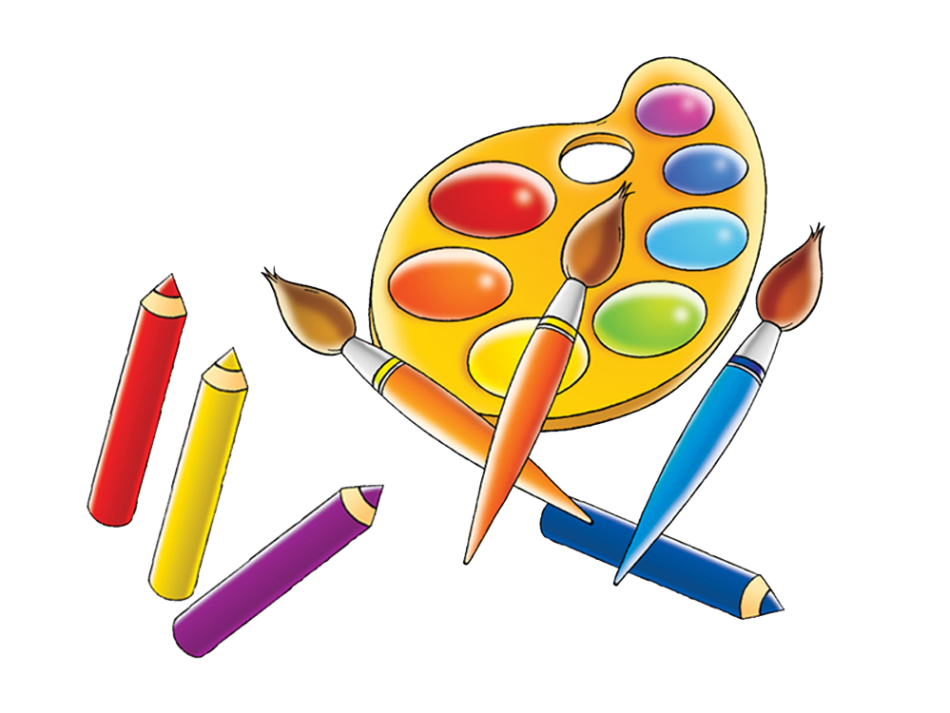 Drawing tools
Drawing tools At the youngest age the child pays more attention to the qualities that this or that material has, the drawings of five-year-old children can already be understood and comprehended, at 10 years the child is already making plot drawings.
Drawing helps to establish and strengthen the connection of the right and left hemispheres of the child's brain, so it affects the development of the baby so much.
Drawing materials for today are very diverse, from crayons to all kinds of colors.
Drawing paints( finger, watercolor, gouache).
In Europe, drawing paints with children from 6 months old has been practiced for more than 20 years and has had positive results.
It's the colors that give you more scope for fantasy.
- First, they are more convenient to draw, when working with them, you do not need to exert any effort, either when drawing with pencils or felt-tip pens
- . Secondly, they can be mixed and get new colors and shades of
- . Third, you can use different drawing tools,the child can choose the most pleasant way to him.
Finger paints
Finger paints will perfectly suit the smallest ones, because they are made of safe materials, and even if the child licks the finger in the paint, moms have nothing to worry about. In addition, such paints are easily washed and washed off clothes. This is a pretty nice bonus, because the crumb does not stop just drawing on paper.
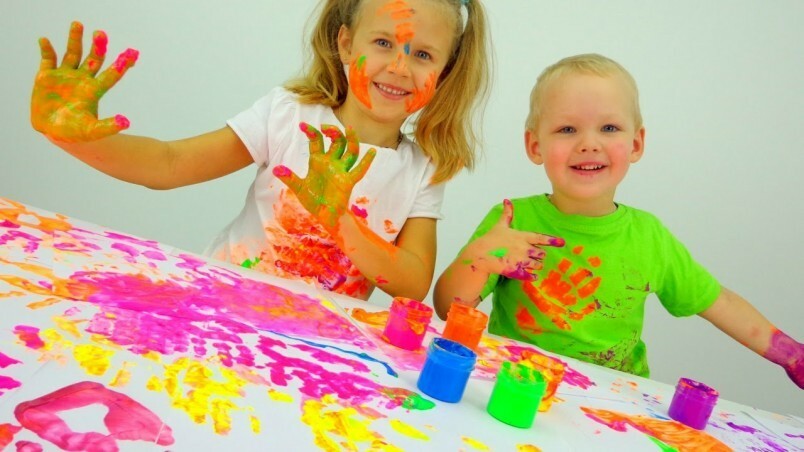 Drawing with finger paints
Drawing with finger paints For more details about these paints, how to use them and the recipe for their preparation at home, see Finger paints. Benefits of paints for the development of the child
Gouache
Gouache is suitable for children a little older, from about two years, becauseit is not as safe as finger paints and harder to wash. Gouache, too, you can draw with fingers, palms, or you can brush. Let the child begin to paint it, as well as his usual finger paints, and then show him how to do it with a brush. But remember, before 3 years, children can not properly hold the brush and control the intensity of depression, so do not require too much of the baby, let him learn.
Gouache very much is pleasant to children, sincehas the following properties:
- it is opaque
- it is very soluble in water
- it can be painted on canvas and on a sheet of paper and even on wood
- dries well and after drying it becomes matte and velvety
- without smell, so it suits the children
- it is very dense, with a saturated color
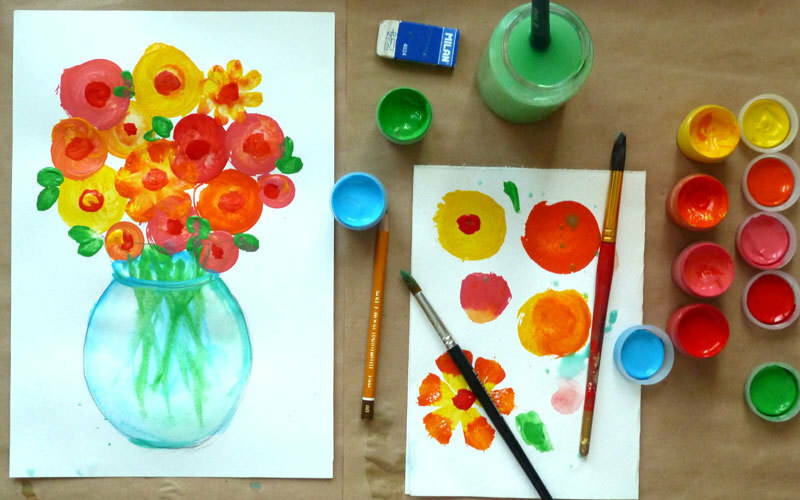
Drawing with gouache
From two years old, the child can be given coloring, just choose large drawings with a minimum of details to start. Show the child how to paint, without going abroad. Try different colors.
Gouache is very good because you can mix colors and get new ones. This lesson should please the young researcher.
Watercolor paints
Since the age of four, the child's drawings are already acquiring more recognizable shapes and he can already give watercolors.
Watercolor is a water-soluble paint, so it is well washed off with water. Painted with watercolor paintings create the impression of weightlessness, translucency and lightness.
The smaller the baby, the fewer colors to choose. For a schoolboy, 12 colors are enough, for children younger and even less. Colors of watercolors can be mixed on a separate palette and get new colors and shades.
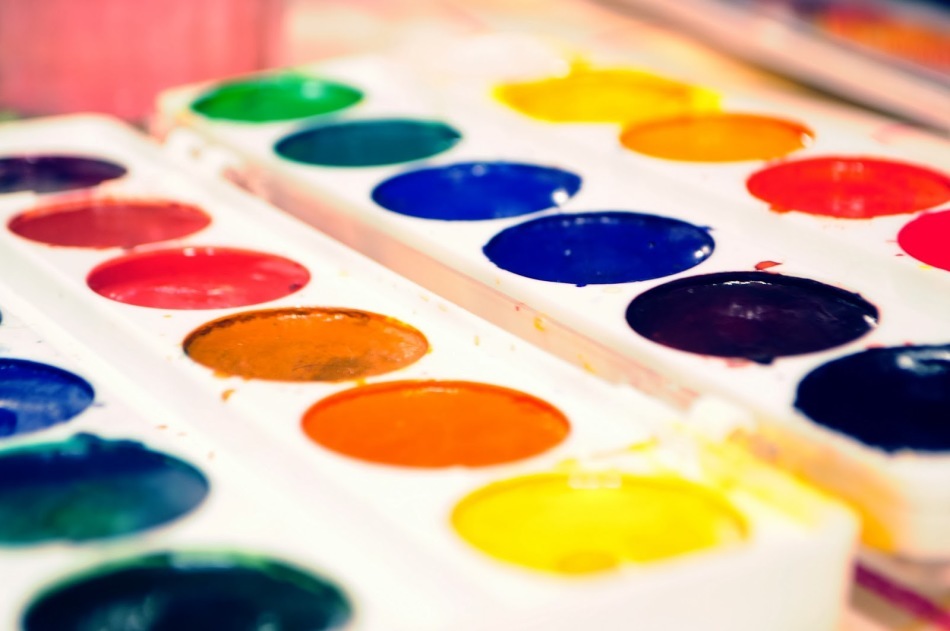 Watercolor paints
Watercolor paints You will also need brushes to work with watercolor, it is better to choose soft and qualitative ones, for example, made from pile ponies or squirrels.
Explain to the child that before taking a new color, the brush should be thoroughly washed in water, otherwise the colors will mix.
There is a special watercolor paper, it differs from the usual one in that the pictures on it turn out to be brighter and, accordingly, live. In addition, it will not wrinkle from moisture.
Drawing techniques for paints
There are a lot of techniques for drawing paints and all of them are very interesting, you and your child need to try them out, because by drawing with different tools, the child develops, expands his horizons, learns new objects, phenomena and actions.
Many different paint drawing techniques you will find in the article Different techniques of drawing paints. Drawing with paints with children
Drawing with pencils( classical, watercolor, wax)
It is more difficult to draw pencils for a child than with fingers with paint, but you need to develop the handles and give the child to try all the drawing tools.
There are several types of pencils:
- classic
- watercolor
- wax
Classical pencils
These pencils were painted by us in childhood: a color lead in a wooden case. The variety of such pencils now in stores is amazing: imported and domestic production, sets of 6 colors and large ones for 64 or more colors, thick and thin, round and triangular. .. The choice of pencils is great, but you need to carefully select them for your child.
- Children under 3 years old are better off choosing pencils trihedral, they are more comfortable to hold and they form the correct grip of the child. In addition, such pencils will not roll down the table to the floor and they will not have to be raised constantly.
- Kids should be given pencil drawings thicker, so that the body is about 1cm, then the lead is not so often broken. Strongly thick to choose is not worth it, they will be uncomfortable with small hands
- The griffin should not be fragile so as not to break constantly from falling to the floor.
- Choose soft pencils so that the child does not have to make efforts, otherwise he will lose interest in the lesson. Soft pencils are marked with a Latin letter B, solid - H
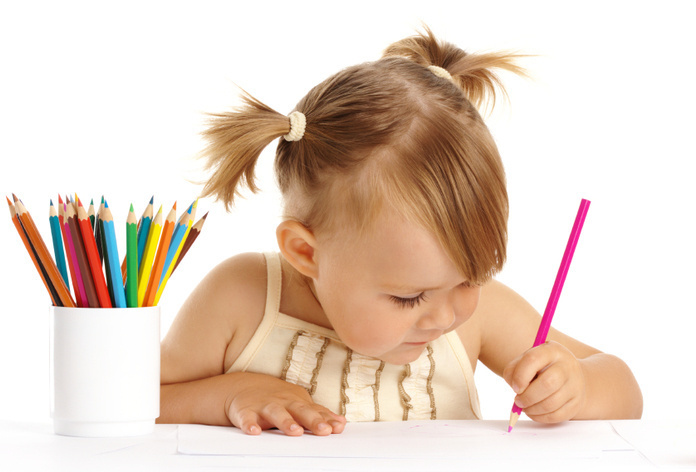 Drawing with pencils
Drawing with pencils We can recommend you pay attention to the pencils of the following companies: Crayola, KOH-I-NOOR, JOVI.They meet all of the above requirements.
Watercolor pencils
This kind of pencils is also made in a wooden case, but instead of the lead there is a pressed watercolor. It turns out like 2 in 1 - and watercolors and pencils. Drawing with such a pencil, you can carry a wet brush on top and get a drawing painted with paint.
- The rod in such pencils is made in a special way that does not allow it to crumble
- They are very soft and brightly paint, better than classic
- . Expensive
- Wooden case round or hexagonal, of usual thickness, i.e.not suitable for small children
- Children draw with such pencils with great pleasure
Wax pencils
Wax pencils are also good for children. They are made of wax with the addition of food colorings.
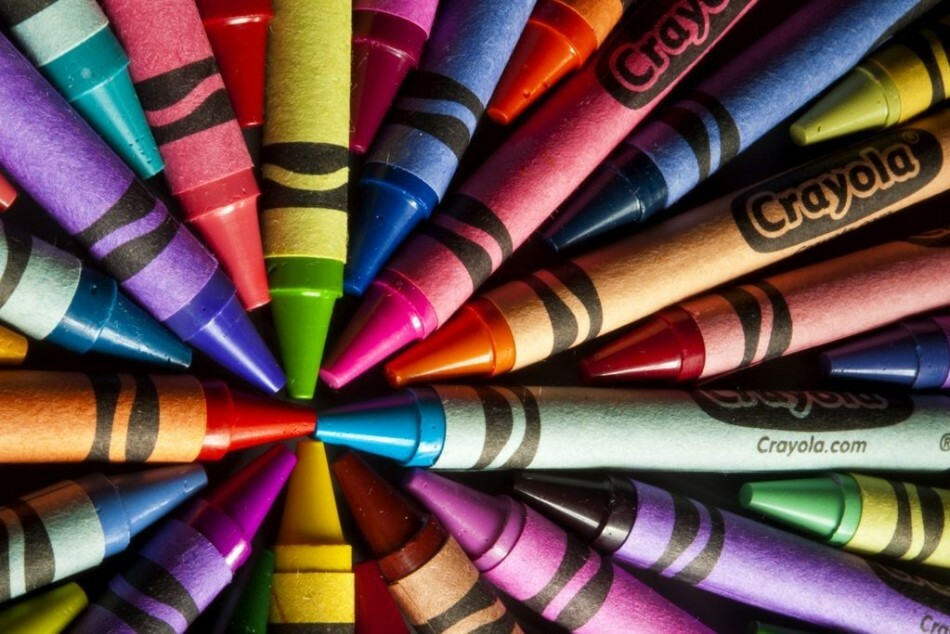 Wax pencils
Wax pencils - They are bright, drawings made with wax pencils do not fade with time, they do not lose the saturation of
- . They do not leave any marks on their hands, although they do not have a protective case
- . Can be drawn by either side or even
- edge. It's easy to sharpen
- Soft, do not needmake efforts to draw a line, which is suitable for kids
- Wax pencils easily fit on paper, so they are easy to paint large areas
- Draw on many surfaces: paper, cardboard, wood, Lina, you can say to everyone except the glossy paper wipes
- ordinary eraser
- There are thick and three-edged for the smallest
Such pencils there are drawbacks:
- they are uncomfortable to paint small details and draw thin lines of
- if they are very thin, then often their children break
- some firms wrap each pencil in a paper wrapper that children constantly try to take off or gnaw
Drawing felt-tip pens( classic, water-soluble, for boards, withstamps)
Felt-tip pens are one of the most favorite drawing tools for children. They deserve such love with precise and very bright lines, which they leave without the slightest effort. And they do not need to be sharpened.
Be careful, markers are not recommended for use by children under 3 years old, because a small child can swallow a cap with which the felt pen is closed.
There are such markers, in which the cap is made with ventilation. Check that the packaging is written that they meet the standards of BS 7272/90 .This indicates that ventilation in the cap passes more than 8 liters of air per minute, so the baby will not suffocate if it gets stuck in the airway until medical help arrives.
 Drawing with felt pads
Drawing with felt pads Also note the cap, it should not be removed from the case in accordance with the standard NFS 51-205 .In this case, the baby can not open the marker and disassemble it.
Pay even more attention to the ink in the felt tip pen, choose made on a water basis, without a strong smell, preferably in the composition with food colorings.
Water-soluble markers are easily laundered from the skin and many surfaces, so they are good for young children who will paint them all around. Another of their advantages is that if you forgot to close the cap, it is enough to lower the rod into the water and they will draw again.
As well as pencils, markers for babies are better to choose thick, about 1 cm in diameter and trihedral.
Small researchers like to check the strength of felt pens and press the rod inward, pressing on it. Therefore, it is better to choose markers with a wide rod or a special design that does not allow the core to be pinched in. Pay attention to this when choosing the markers for your child.
There is one more kind of markers - with stamps .They have a seal instead of a rod. Working with these tools is very exciting for children, but up to 4 years old children do not know how to accurately put seals themselves and they are lubricated, so do not give them to babies.
 Felt-tip pens with
Felt-tip pens with stamps There are also markers for boards, they can be painted on a special children's easel or dostochke. They are usually washed with a dry cloth. Some need to wash wet. Children are very fond of drawing on boards, because the drawing can always be corrected or changed, and then wipe and draw something else.
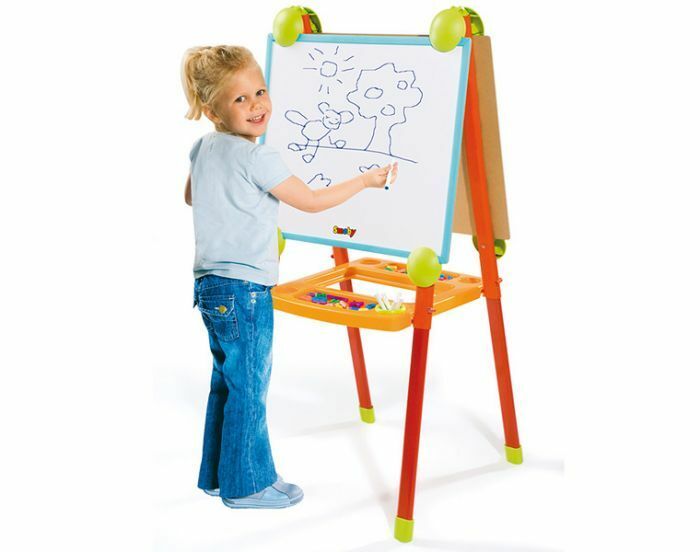 Drawing on the easel
Drawing on the easel Drawing with crayons
Walking outside is not compatible with the drawing lesson? Very compatible! Bring crayons and paint with the child on the asphalt. Mel is well washed off from hands and clothes, and how much he will bring to the child of pleasure and advantage.
Play with the child in the following educational games:
- circle an object, for example, a bucket or a piece of
- the resulting contour can be drawn
- circle a shadow from an object, a person or, for example, a tree;you can do this at different times of the day to observe how its location changes
- draw a contour of an object or an animal with dots or strokes, let the child connect them with a single line
- let the child paint on the wall of the house or on a tree, in general, on anyvertical surface - it will be very interesting for him.
- study forms: draw some shape, for example, a circle, and ask the child to finish the details so that it turns into a specific object, for example, a ball or a peach.
- try to draw a mokthe kid is sure to like
- on the asphalt track and ask the child to go through it without leaving the border, or rent a car
- draw obstacles, let the child bypass them or jump over the
- draw circles, and let the child jump from one to another,as a bunny
- you can learn the alphabet: write a letter and draw a subject or an animal that starts with this letter for older children, for example, draw an orange, and let the child call and write the letter A
- forolder children is well developed by imagination and speech the following game: one child draws several objects, and the second comes up and tells a small story related to them.
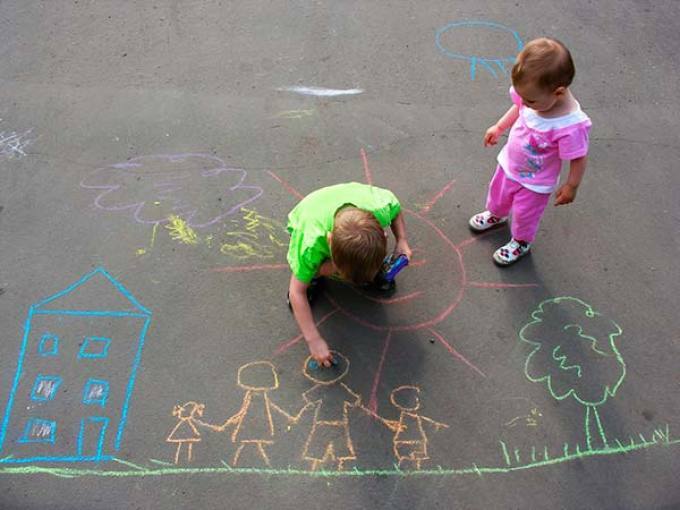 Drawing with chalk
Drawing with chalk With chalk, you can come up with many developmental games for the child, including studying the shape,colors, numbers, letters. But the main thing is that drawing was a child's pleasure.
Working with plasticine or a test for modeling and its impact on the development of a child
Almost all babies like to sculpt various figures. They get from this not only pleasure, but also great benefit. Parents like this activity, because the child can spend quite a lot of time with plasticine, he does not run there at the time, does not watch cartoons, does not do school. But the benefit for the child from practicing modeling is much greater than it seems at first glance.
The use of modeling for the intellectual development of
- modeling develops small hand mechanics that favorably develops the speech
- modeling helps to cope with coordination, improves memory and makes you think logically
- the child becomes more patient and assiduous
- children develop abstract thinking, they create images,use their creative abilities
- modeling contributes to the simultaneous operation of both hemispheres of the brain, due to which their relationship is strengthened
- the child learns by comparing
- in children develops imaginative thinking and imagination
- the child learns to perform the intended, go to the ultimate goal, focus
 Occupation modeling
Occupation modeling The use of modeling for the health
- molding well reflects on the nervous system of the child
- as well asany other quiet occupation, modeling contributes to improving sleep, reducing irritability, removes overexcitability
- doing modeling, the child expresses his feelings that may not beOnly positive, it helps to cope with their negative emotions
- with the help of modeling you can learn to overcome fears by breaking "bad" figures or changing them, turning something positive into
- by analyzing child-molded figures, adults can understand the child's psychological state and recognize problems
- works with plasticine on time, the child calms down, forgets bad emotions, relaxes
- modeling for children acts as a mediator between a fictional world and the present, it helps dCham understand our world
- creating crafts, the child is asserting itself, believe in themselves, looking for innovative solutions to difficult situations
Benefits modeling for personal development
- work with plasticine helps to show the child his uniqueness, reveal his creativity and develop them
- when doing modeling, the child gets knowledge about various forms and colors, he learns to distinguish the properties of objects and texture to the touch
- the child learns to experiment, develops curiosity
- creating crafts, childrenapply their knowledge and skills to get the desired result
- working on a craft, the child trains his visual perception of the world, pays attention to details, becomes a bole careful, exploring a variety of objects, their qualities and properties
- such classes, as well as any work, affects the aesthetic education of the child
 figurines from clay
figurines from clay Materials for class modeling Plasticine
- .It is suitable for children older than 3 years, becauseit is more difficult to knead the unfixed handles. Examples of crafts that can be sculpted with children, you will find in the article Staged modeling for children. Crafts from plasticine: we model food, animals, toys
- Wax plasticine .Suitable for small children, too.due to its wax base, it is softer and more plastic
- Clay for molding. Clay is good for its low cost. Interesting selling kits for working with clay, for example, for modeling pots.
- Modeling paste .It is produced only in white color and color of terracotta, so after solidification it should be decorated. By the way, it freezes itself, baking does not require
- Dough for modeling or salted dough .You can buy it ready, but you can do it yourself. Ideal for practicing modeling with young children.very soft and harmless. Many interesting ideas for modeling with step-by-step photos and instructions you will find in the article Crafts from salty dough with your own hands. Crafts for the holidays
- Mass for modeling .Pleasant to touch, but very expensive. It is better to use it, for small work with a lot of details. Freezes on its own for 6-8 hours
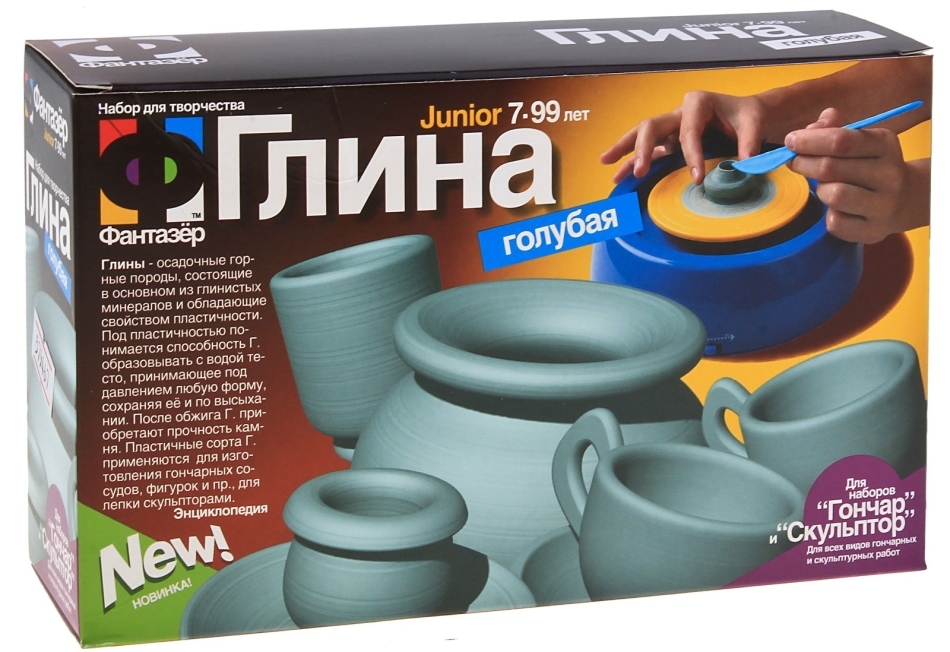 Set with clay for sculpting
Set with clay for sculpting More detailed description of each material, as well as tips on how to teach a child to sculpt from plasticine, you learn from the article Lepim with children from plasticine. Plasticineography
Plasticineography
Plasticineography is drawing on paper with the help of plasticine.
Prileplavaya clay or smearing, we get three-dimensional pictures.
Benefits for the child from plasticine combine the benefits of drawing and modeling, becausethe child applies both techniques in his works. Creating such a pattern, the child learns to own his own hands, tries with different intensity finger pressure, makes them unusual movements that help develop the fine motor skills of the hands.
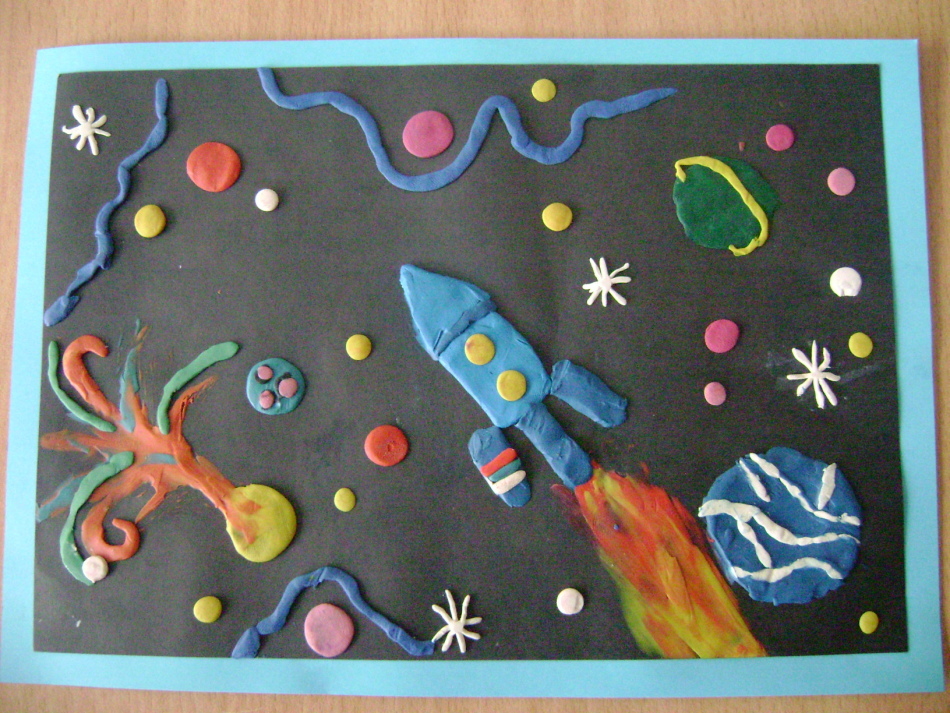 Work in the technique of plasticine
Work in the technique of plasticine For different ages of children, you can offer a different complexity of the job, from the simplest pieces of plasticine that mimics the rain under the cloud, to unique paintings with lots of little things and details.
Use of the applique in the development of the child
Application - this gluing anything on any surface. More often than not, children paste colored paper onto the cardboard.
This kind of creativity you can do with the kids. Since the year, with the help of adults, a child can glue various elements onto paper or cardboard. The older the child, the less he needs the help of an adult.
The benefits of this kind of creativity, as well as from others, is enormous. Engaging in such hard work, the child learns patience, develops assiduity, trains attention, displays accuracy, carving out details. Cutting, applying glue, and self-gluing very well develop the small motor skills of the child's hands.
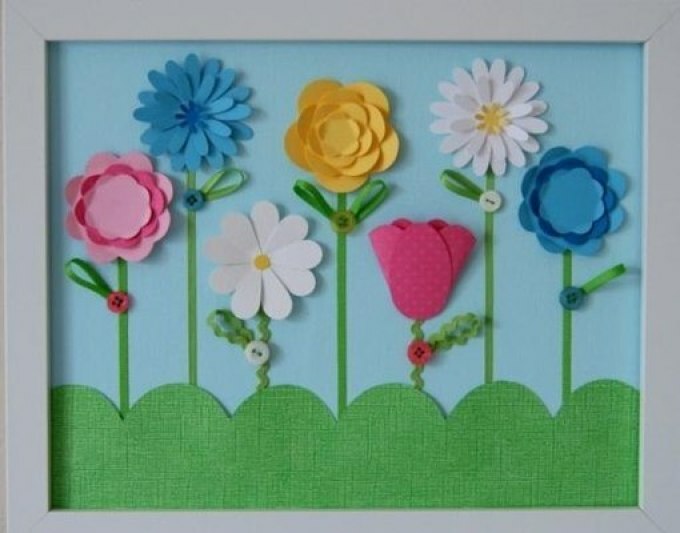 Application on paper
Application on paper Use of application in the development of mental abilities
- child gets acquainted with the concepts of form, color, texture
- compares details and finds the same
- teaches the differences in the size of the details, small-large
- shows imagination and creativity in creating their works
- sees the main among the secondary
- finds parts of the whole and learns to collect them
In addition, the child receives satisfaction from the result of his work, learns to do something himself and give his own crafts or decorate their house.
Materials for application
- are sold special sets already with ready-made parts and the basis of
- you can draw details yourself and cut them
- you can still find schemes on the Internet, print them and cut
- also you will need a base, it can be white or colored cardboard, Whatman, just paper, paper with some drawings or an interesting texture
- glue, scissors
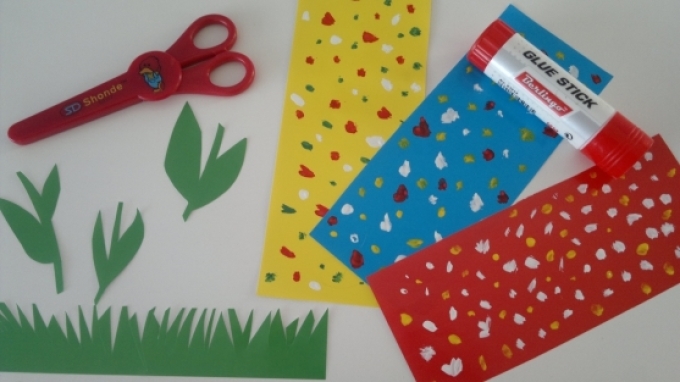 Materials for application
Materials for application Sequence of actions for using applications from paper
- Think of a picture or a storylineso you want to get a result. Take into account the desires of the child and his sex
- Cut out the details you need
- Stick them on the
- framework. Make the work and do not forget to praise the child.
Turn the activity into a game, tell the child a fairy tale, for example, about a kolobok, and let the kid stick characters on the paper. By creating a fairy tale with your own hands, the child will assert himself and with pleasure continue to use the application.
Application of cereals
Groats are a safe natural material for classes with children. Applications of cereals are good because they do not require special tools, only the base, glue and groats are needed.
- The cereals can be painted in different colors, so the child will learn them
- Groats well annoy the nerve endings on the fingers and promote the development of fine motor skills.
- . The child learns new material through tactile sensations.
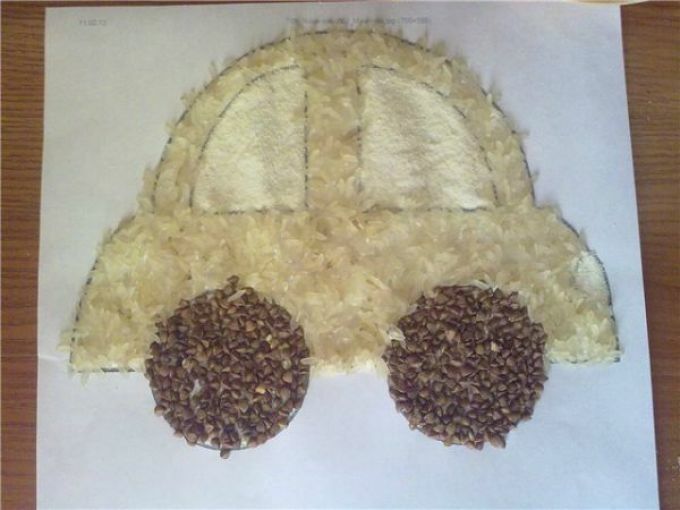 . Application of cereals
. Application of cereals . There are two techniques for working with cereals:
- .To do this, glue with glue or glue the double-sided adhesive tape on the base in the right place and ask the child to sprinkle it with groats - it will be stuck on the
- Pressing. In the right place, stick the clay on the base and press in it the rump of
. For different parts, use different croup or its color, for example, make a cloud of rice and the sun from millet.
Other types of creativity
Other types include sticking of stickers on paper or cardboard. This lesson will be very like even the smallest. From a year old the child can be given to touch the sticky side, so the child will get acquainted with the properties of the object. Show how to remove stickers and how to glue. Children can thus make postcards for holidays to relatives.
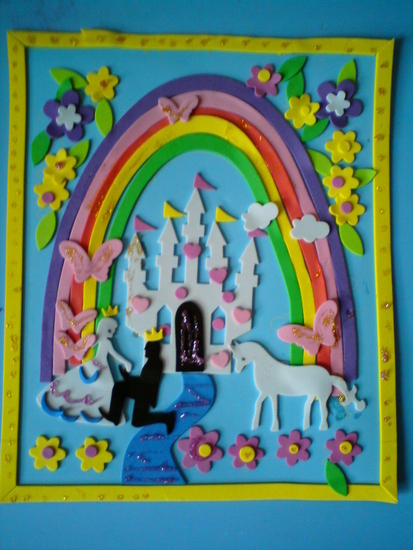 Work with volumetric stickers
Work with volumetric stickers - Fold colored cardboard in half, in the form of a postcard
- Give the child a thematic sticker, the image of which depends on the holiday
- Help the baby to peel them off the backing and stick them onto the
- carton. Give a felt-tip pen, let it ink inside
- wish. Postcard ready
Forsmall children from 1 year to 2 is better to take volumetric stickers, they keep a good shape, do not curl up in inept hands and the baby is comfortable with them.
Crafts made of natural material favorably influence the harmonious development of the child as a person. The child learns to apply various materials that he can find for a walk. This develops mindfulness, erudition, curiosity, creative thinking, helps to learn the world of nature closer.
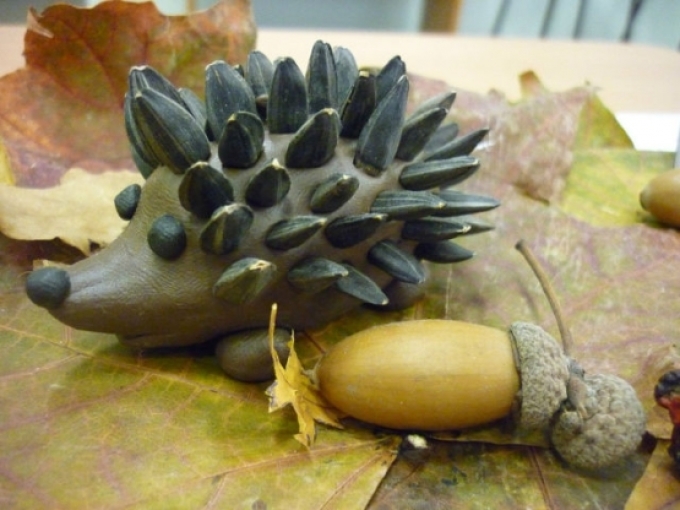 Handicraft from natural material
Handicraft from natural material 